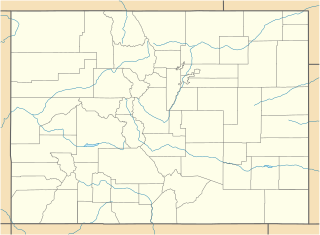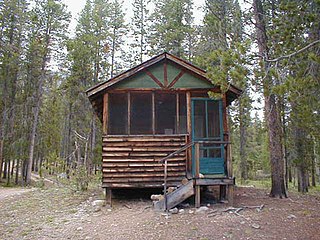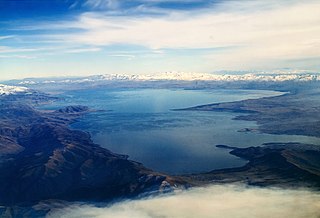
Mesa County is one of the 64 counties of the U.S. state of Colorado. As of the 2010 census, the population was 146,723. The county seat is Grand Junction. The county was named for the many large mesas in the area, including Grand Mesa.

Grand Lake is a statutory town in Grand County, Colorado, United States. The population was 471 at the 2010 census.

Grand Junction is a home rule municipality that is the county seat and the most populous municipality of Mesa County, Colorado, United States. The city has a council–manager form of government, and is the most populous municipality in all of western Colorado. Grand Junction is 247 miles (398 km) west-southwest of the Colorado State Capitol in Denver. As of the 2010 census, the city's population was 58,566. Grand Junction is the 15th most populous city in the state of Colorado and the most populous city on the Colorado Western Slope. It is a major commercial and transportation hub within the large area between the Green River and the Continental Divide. It is the principal city of the Grand Junction Metropolitan Statistical Area, which had a population of 146,723 in 2010 census.
The Western Slope of Colorado refers to a region of the U.S. state of Colorado incorporating everything in the state west of the Continental Divide, including Moffat, Routt, Hinsdale, Grand, Summit, LaPlata, Montezuma, Dolores, Eagle, Pitkin, Rio Blanco, Garfield, Mesa, Delta, Montrose, Gunnison, Ouray, and San Miguel counties and portions of Saguache, Archuleta, Mineral, and San Juan counties. The Colorado River and its tributaries divide the region into north and south at Grand Junction, Colorado. The area has a climate similar to that of the Great Basin.

Grand Lake is Colorado's largest and deepest natural lake. It is located in the headwaters of the Colorado River in Grand County, Colorado. On its north shore is located the historic and eponymous town of Grand Lake. The lake fills a glaciated valley that is dammed in part by glacial till from the Pinedale Glaciation, and is younger than about 12,000 years. Natural tributaries to the lake are the North Inlet and East Inlet, both of which flow out of Rocky Mountain National Park, which surrounds the lake on three sides: Grand Lake is located 1 mile from the Park's western entrance. Grand Lake was named Spirit Lake by the Ute Tribe because they believed the lake's cold waters to be the dwelling place of departed souls.

The Arizona Strip is the part of Arizona lying north of the Colorado River. The difficulty of crossing the Grand Canyon causes this region to have more physical and cultural connections with southern Utah and Nevada than with the rest of Arizona. The largest settlements in the Strip are Colorado City and Fredonia.

Colorado's 2nd congressional district is a congressional district in the U.S. state of Colorado. The district is located in the north-central part of the state and encompasses the northwestern suburbs of Denver including Boulder, Northglenn, Thornton, and Westminster. The district also includes the mountain towns of Vail, Grand Lake and Idaho Springs. Redistricting in 2011 has moved Larimer County, including the cities of Fort Collins and Loveland, to the 2nd from the 4th district for the 2012 election.
Murphy Lake may refer to:

Shadow Mountain Dam is a zoned earth-fill dam on the Colorado River in Grand County, Colorado. Constructed between 1944 and 1946, the Shadow Mountain Dam creates the Shadow Mountain Lake, with a structural height of 63 feet (19 m) and a drainage area of 187 square miles (480 km2). Shadow Mountain Lake is a holding reservoir for water pumped up from Lake Granby just to the south through the Granby Pumping Plant and Canal. Shadow Mountain Lake is connected by a short channel to the natural Grand Lake. The west portal of the Alva B. Adams Tunnel is located on Grand Lake. The Adams Tunnel diverts west slope water to the east slope of the Rocky Mountains for use in agriculture and to serve the populated areas of Colorado, including Denver.

The Arapaho National Recreation Area (ANRA) is a United States National Recreation Area that is located near the headwaters of the Colorado River in north central Colorado adjacent to Rocky Mountain National Park. ANRA is under the jurisdiction of the Arapaho-Roosevelt National Forest. ANRA contains five lakes in the upper Colorado River Valley:
The High Rockies, or high country, is a term for a region of the U.S. state of Colorado. It commonly includes Larimer County, Jackson County, Routt County, Grand County, Summit County, Eagle County, Lake County, and Pitkin County. Some notable towns there include Estes Park, Walden, Steamboat Springs, Grand Lake, Winter Park, Breckenridge, Dillon, Vail, Leadville, and Aspen. The geography of the High Rockies has some of the most rugged parts of the Rocky Mountains and consists of the Front Range and mountainous topography to the west, much of which is on or near the Continental Divide. Known for pine forests and winding roads, the former mining towns there have been reinvented by wilderness tourism such as hiking, cycling, fishing, and most especially both cross-country and alpine skiing. Notable ski resorts include Copper Mountain, Keystone Resort, Steamboat Ski Resort, Beaver Creek Resort, Buttermilk, Aspen Highlands, Snowmass, and Aspen Mountain. The High Rockies are also the location of Rocky Mountain National Park and Arapaho National Forest.

The James M. Robb – Colorado River State Park is a Colorado State Park along the Colorado River in Mesa County near Grand Junction, Colorado. The 890-acre (3.6 km2) park established in 1994 has five distinct sections providing access to the river. The Island Acres and Fruita segments have campsites and swim beaches. The other three segments, Corn Lake, Connected Lakes and the Colorado River Wildlife Area are for day use only. Corn Lake, Connected Lakes and Fruita have boat ramps. The downriver float trip between Corn Lake and Connected Lakes is about 10 miles (16 km), as is the trip between Connected Lakes and Fruita. Both trips include some class II rapids.

The Grand Lake Lodge was opened in 1920 to serve tourists visiting Rocky Mountain National Park via the Trail Ridge Road, completed the same year. Located in Grand Lake, Colorado, the rustic lodge was founded by Frank Huntington and Roe Emery on land owned by the National Park Service at the edge of the park. The resort was affiliated with the Chicago, Burlington & Quincy Railroad. In 1963 the lodge owners were able to exchange park inholdings they had acquired for the lands related to the lodge, removing the lodge from the park.

Hallett Peak is a mountain summit in the northern Front Range of the Rocky Mountains of North America. The 12,720-foot (3,877 m) peak is located in the Rocky Mountain National Park Wilderness, 10.1 miles (16.2 km) southwest by west of the Town of Estes Park, Colorado, United States, on the Continental Divide between Grand and Larimer counties.
Haynach Lakes is a lake in Grand County, Colorado. Haynach Lakes lie at an elevation of 11,069 feet (3,374 m).
Snowdrift Lake is a lake in Grand County, Colorado, United States. It is part of Rocky Mountain National Park. Snowdrift Lake lies at an elevation of 11069 feet, below Snowdrift Peak.

Mount Alice is a high mountain summit in the northern Front Range of the Rocky Mountains of North America. The 13,315-foot (4,058 m) thirteener is located in the Rocky Mountain National Park Wilderness, 12.0 miles (19.3 km) southwest by south of the Town of Estes Park, Colorado, United States, immediately east of the Continental Divide between Boulder and Grand counties. Just who the namesake Alice was is unclear, but according to one source she was likely a "woman of ill repute".

The Holzwarth Historic District comprises a series of cabins built by the Holzwarth family as a guest ranch inholding within the boundaries Rocky Mountain National Park, at Grand Lake, Colorado. The Holzwarths made their homestead in the Kawuneeche Valley in 1917, two years after the establishment of the park, and received a patent on the homestead in 1923. Guest ranch use began in 1919 and continued until the ranch was purchased by The Nature Conservancy in 1974. The property was transferred to the National Park Service in 1975 for incorporation into the park. The district comprises a number of rustic cabins on the Colorado River. Operations existed on both sides of the river, first known as the Holzwarth Trout Ranch and later as the Never Summer Ranch. All but Joe Fleshut's cabin have been removed from the east side of the river.















